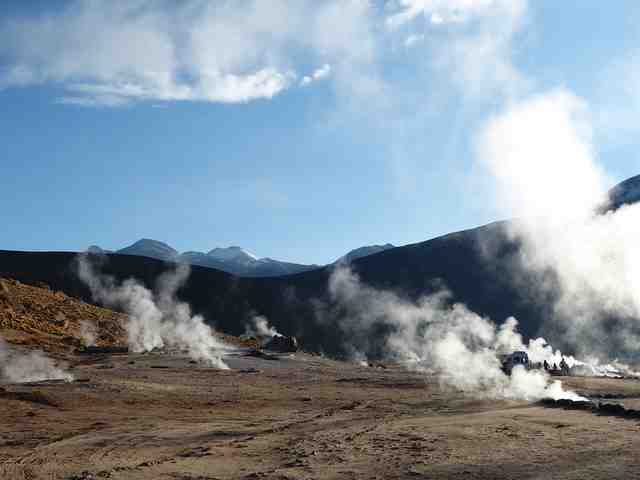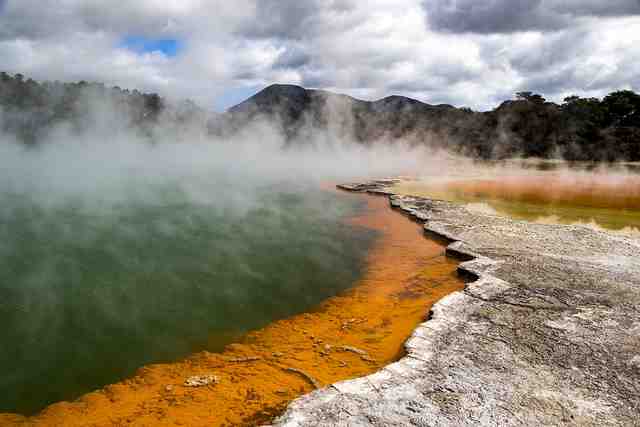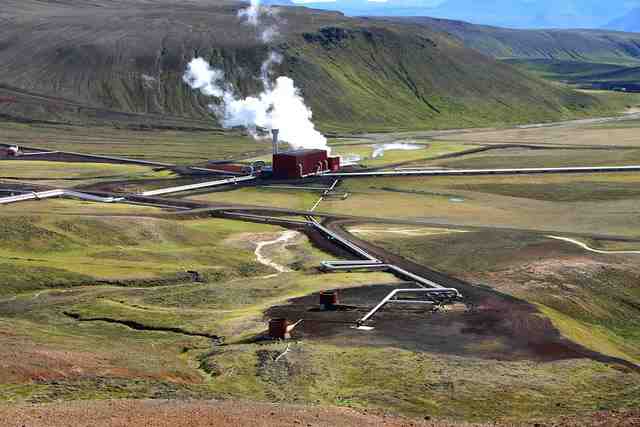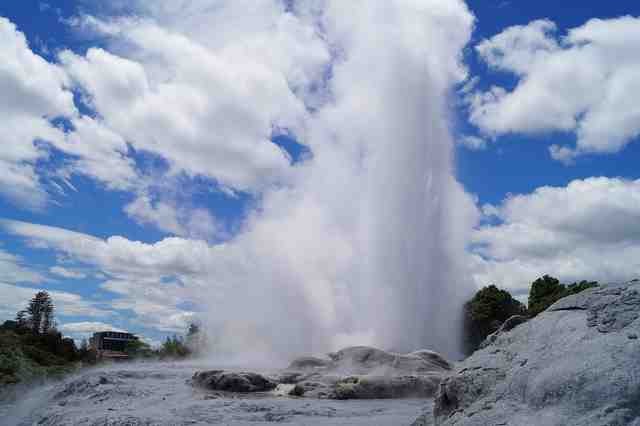Geothermal energy is an example of a non-conventional energy source consisting of two words, ‘Geo’ meaning ‘earth’ and ‘thermal’ meaning ‘heat.’
It is a form of energy produced by natural radioactive decay of certain radioactive elements and stored within the earth’s crust.
Direct application of geothermal energy dates back to thousands of years ago when the Romans, Chinese, and Native Americans used it for bathing, cooking, and therapeutic purposes.
Today, geothermal fluids find their usage in multiple applications depending on the temperature.
It includes electricity generation (above 1500C) and other low-temperature uses such as space heating, farming, and industrial processing.
Developing countries like India, having limited reserves of other energy sources; coal fills much of the growing energy demands.
There are other non-renewable energy sources such as oil, natural gas, wood, etc., but they are dangerous for the environment.
Geothermal energy does not require any fuel for electricity production. As a result, its GHG emissions are negligible compared to fossil fuels.
In this article, we will learn about geothermal energy, its uses, advantages, and disadvantages.
What is Geothermal Energy?

Geothermal energy is the natural heat energy produced and stored inside the pores and cracks within the rocks of the earth’s crust.
Heat passes outward from the crust by natural cooling, radioactive decay of certain dispersed elements (such as uranium, thorium, and isotopes of potassium), and various chemical reactions.
Earth’s inner core can attain a maximum temperature of about 4000–4500°C as compared to an average temperature of 15°C at the surface of the crust.
The earth’s heat flow depends upon the geological conditions; thus, it varies from place to place and with time.
Various natural sources of geothermal energy are hot springs, volcanoes, geysers, or underground reservoirs.
Latest technologies use water as the heat carrier to harness geothermal energy from underground surfaces.
Earth’s crust is highly porous, so water from the surface can easily penetrate inside, and exchanges heat with the hot rocks.
In this way, circulating water can efficiently transfer a large amount of heat to the surface at various temperatures that can be used in power production or other direct applications.
Normally Geothermal resources in any particular area can last for 20-25 years but can be exhausted if the extraction rate is more than the natural heat recharge.
However, water supply makeup and new wells drilling can reduce this problem partially.
Geothermal resources are available globally, and most of them are in Coastal North America, rift zones of East Africa, North Africa, Mediterranean basin of Europe, and Asia to Pacific.
Geothermal Energy Uses
There are three main uses of geothermal energy, as listed below;
1. Direct Supply in the form of Hot Water

In many locations across the world, geothermal heat is available at approx. 50-150 °C in the form of hot water.
There are many applications of direct hot water /steam without the need for any specialized equipment. Some of them are
- Building heating
- Swimming pools, Spa, and aquaculture ponds
- Cooking
- Drying fruits, vegetables, and timber
- Large-scale snow melting
- Greenhouse cultivation
- Other Industrial applications such as leaching & extraction
2. Electrical Power Generation

Electricity generation requires rotating a turbine using steam that further drives an electrical generator to produce power.
In a few locations, geothermal heat is available at a temperature of more than 150oC in the form of naturally flowing water and/or steam that is perfect for electricity production.
Most power plants use fossil fuels like coal/natural gas to boil water for steam generation, but geothermal power plants directly use the rising steam from the ground to drive the turbine.
If direct steam is unavailable, then they use the hot underground fluid (steam + water) to heat water for steam production.
3. Geothermal Heat Pumps Operation

Electrical powered heat pumps take the heat at relatively moderate temperature (5-300C) from near-surface ground to a depth of usually 3-6 m.
This system is called a geothermal heat pump, and it provides heat to buildings during the winter months when the air temperature falls below that of the ground.
As the ground surface temperature remains constant throughout the year, so, during the summer months, geothermal heat pumps can keep the building cool.
They extract heat (warm air) from buildings and circulate it through the ground surface that is at a relatively colder temperature.
Advantages of Geothermal Energy

1. Environment Friendly
Direct use of geothermal energy in the form of hot steam and/or water negates the consumption and burning of fossil fuels.
This reduces GHG emissions by at least 90%, which positively impacts the environment due to lesser air pollution.
In addition, harnessing geothermal power does not produce salt & mineral residues as they are reinjected back into the reservoirs.
Sometimes, geothermal plants produce sludge, but they are disposed of in the approved sites.
Geothermal power-operated equipment does not cause much noise pollution, unlike conventional heating/cooling systems.
2. Geothermal Power Plants use Less Operating Area
For producing a KW of power, geothermal plants use less land area than conventional coal and nuclear power plants.
Furthermore, there is a minimum environmental impact upon the land they use.
Data from Energy Efficiency & Renewable Energy states the following land usage pattern by various types of power plants:
| Power Plant Type | Land Area (Acres/MW) |
| Geothermal | 1-8 |
| Nuclear | 5-10 |
| Coal | 19 |
3. Geothermal Energy is Renewable
Geothermal energy is available freely and in abundance.
In contrast to conventional hydrocarbon resources, geothermal resources are generally renewable as there is a continuous flow of heat and fluid from the inner layer to the earth’s surface.
Scientists also believe that the geothermal energy accumulated in the reservoirs can last for billions of years.
Earth’s heat is harnessed at different rates ensuring sustainable use by controlling the consumption rate with respect to the generation.
4. Geothermal Energy has direct applications
The most distinct advantage of geothermal energy is its direct usage.
Most of the cold countries use the hot water directly for ice melting or bathing purpose.
5. High Efficiency
Although geothermal pumps are electrically operated, they are the most energy-efficient.
Geothermal pumps use a unit of electricity to produce 3-4 units of energy that translate to over 400% efficiency.
6. Low Maintenance
Geothermal systems have fewer moving parts, and they are long-lasting, thus requiring less maintenance.
The initial investment cost is high, but they are relatively cheap to operate & maintain.
The cost for operating & maintaining a geothermal power plant ranges from $0.01 to $0.03 per kilowatt-hour and can operate at 90% availability or more.
7. Geothermal Power is Reliable
Geothermal energy is constantly available 24 x 7, whereas wind and solar power are available for almost one-third of the total time.
It is an extremely reliable energy source, which remains unaffected by changing environmental patterns & voltage fluctuations.
Geothermal power plants are flexible enough in ramping up the power load as per the current demand maintaining its integrity.
8. Reduction in Utility Bills
Geothermal system installation requires high initial investments as compared to conventional ones.
Due to this reason, geothermal installation is not so popular, but when the system becomes operational, it will reduce your utility bills by almost half.
The average life of a geothermal heat pump is about 25 years, which is more than the traditional HVAC system that lasts between 15-20 years, so you will have sufficient time to reap the benefits of this system.
9. Local Economic Development
Geothermal power projects can give new wings to the economy of that area.
It has the potential to create new jobs for skilled and unskilled laborers causing local economic development.
For developing countries like India, local geothermal power production minimizes the overdependence on imported oil.
Geothermal plants can boost eco-tourism too. For example, in India, you can visit Manikaran sulfur hot water springs located in the Kullu District of Himachal Pradesh.
10. Wide Availability
Geothermal energy or earth’s internal heat is widely available globally, having the only limitation of harnessing it.
Technology is changing very fast, so it would be possible to extract this energy easily in the near future with advanced resources.
In India, geothermal power generation is still in the nascent stages, but recently, the Geological Survey of India found 350 geothermal energy locations in the country having an estimated potential for about 10000 MW.
The ministry of new and renewable energy (MNRE) has also bought a proposal to harness 10 GW of geothermal energy by 2030.
| More to read! |
Disadvantages of Geothermal Energy

As discussed, geothermal energy has multiple benefits.
Let us now discuss the other side of the coin.
1. Geothermal energy is not 100% eco-friendly
Earth crust may contain small fractions of naturally occurring trapped gases (like sulfur dioxide, methane, and carbon dioxide) that are harmful to the environment.
As an estimate, geothermal power plants can emit 45 to 90 grams of carbon dioxide per kilowatt-hour, whereas a coal-fired power plant releases about 635 to 1650 grams.
Although power plants based on geothermal contributes a very small amount of GHG emissions, it is not zero.
The reservoir may contain toxic metals, minerals, and salts such as boron, mercury, sulfur, and arsenic, but during the production process, they are again pumped back into the reservoir.
2. Harnessing Geothermal power requires a high initial investment
The upfront costs are higher in installing a geothermal power plant, as it requires well drilling and installing complex piping systems.
Proper Installation needs extensive research, which increases the capital cost further.
However, in the long run, there is a probable Return on Investment (ROI).
The capital cost of various power plants are given below;
| Type of Power Plant | Capital Cost ($/kW) |
| Natural Gas | 600-800 |
| Nuclear | 3000 – 5000 |
| Solar PV | 3000 – 5000 |
| Wind | 1600-1750 |
| Geothermal | 1600 – 2000 |
| Hydropower | 1000 – 3500 |
| Coal | 2500-3500 |
3. Noise pollution during Drilling Operations
Borewells are drilled to harness the geothermal energy, but drilling operations can create noise pollution in some development areas.
In addition, drilling operations require heavy machinery and vehicle access throughout the process, creating nuisance in the area.
However, with technological advancements, usage of insulating noise rigs and low noise electric motors in place of diesel-driven motors can reduce this problem.
4. Harnessing Geothermal energy can create seismic events
Hydrofracturing (geothermal fluids withdrawal and/or re-injection) and other associated operations lead to high stress across the development area that can cause frequent seismic events.
In 2017, the construction of a geothermal power plant in Pohang, South Korea, triggered an earthquake with a magnitude of 5.5 on the Richter scale.
However, most geothermal plants are located away from populated areas; hence the impact of earthquakes is limited.
5. A large volume of water requirement during Well drilling
Extracting geothermal energy requires a large amount of water injection into the reservoir.
Over time water loss (10-20%) occurs from the circulating fluids requiring subsequent makeup, leading to supply issues in the nearby area.
6. Electricity generation is not enough
Most geothermal energy systems do not generate enough electricity to make it worthwhile.
Although they can produce enough to fulfill our needs, this will not be enough to make a difference.
It means that we need to either buy electricity from a power company or invest in another green power source.
7. Transmission of Geothermal power is difficult
Transmission & distribution of geothermal power is a concern, as the project sites are located in far-flung areas.
After harnessing the energy, nearby areas can use it effectively as vast distribution networks can increase overall system cost.
Moreover, the chances of toxic emissions and energy losses may increase due to enhanced distribution networks.
8. High-temperature requirement for power production
Geothermal power production requires a temperature of more than 1500C, but most of the areas do not have this much advantage.
In India, most of the identified geothermal belts are in the low surface temperature range from 37oC -90oC that is suitable for direct heat applications only.
References
- Barbier E., Renew. Sustain. Energy Rev., 6 (2002) 3.
- Manzella, Geothermal energy, Institute of Geosciences and Earth Resources – Pisa, Italy (EPJ Web of Conferences)
- http://www.indiaenergyportal.org/subthemes_link.php?text=geothermal&themeid=13
- https://www.britannica.com/science/geothermal-energy/
- Energy Efficiency & Renewable Energy, https://www.energy.gov
- Geothermal Energy in India: Past, Present and Future Scenarios, Jayaraju, N Department of Geology, Yogi Vemana University, KADAPA-516003, AP, INDIA
- Ministry of New and Renewable Energy (MNRE)
- Paul Breeze, The Cost of Power Generation, The current and future competitiveness of renewable and traditional technologies